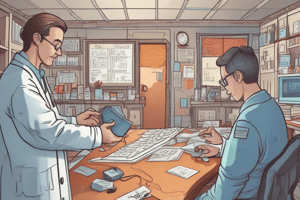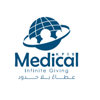Podcast
Questions and Answers
Match the following terms with their definitions:
Match the following terms with their definitions:
Adverse Event = An event that results in unintended harm to the patient by an act of commission or omission Harm = Any physical or psychological injury or damage to the health of a person Hazard = Any source of potential damage or adverse health effects on patients or healthcare personnel Near Miss = Event which DID NOT reach the patient, either through luck or early detection
Match the following terms with their descriptions:
Match the following terms with their descriptions:
Never Events = Patient safety incidents that are largely preventable through known guidelines Invasive Procedure = Interventions that may be surgical but done outside a surgical environment Continuous Improvement = Ongoing enhancement of quality of care and outcomes for patients Clinical Risks = Likelihood that an Adverse Incident will cause injury or harm to the patient
Match the following methodologies with their usage in Continuous Improvement:
Match the following methodologies with their usage in Continuous Improvement:
PDSA = Plan, Do, Study, Act cycle DMAIC = Define, Measure, Analyse, Improve, Control A3 Problem Solving = Structured problem-solving approach Incremental Improvement = Ongoing improvement through small changes
Match the following terms related to healthcare with their implications:
Match the following terms related to healthcare with their implications:
Match the following invasive procedures with their examples:
Match the following invasive procedures with their examples:
Match the following types of events in healthcare:
Match the following types of events in healthcare:
Match the terms related to patient safety with their descriptions:
Match the terms related to patient safety with their descriptions:
Match the following statements with the correct term:
Match the following statements with the correct term:
Match the following terms with their correct definitions:
Match the following terms with their correct definitions:
Match the following categories with their descriptions:
Match the following categories with their descriptions:
Match the following types of events with their implications:
Match the following types of events with their implications:
Match the following components of a Patient Safety Culture:
Match the following components of a Patient Safety Culture:
Match the following concepts with their characteristics:
Match the following concepts with their characteristics:
Match the following strategies with their goals:
Match the following strategies with their goals:
Match the definitions with the correct events:
Match the definitions with the correct events:
Match the following professionals with their roles in Patient Safety:
Match the following professionals with their roles in Patient Safety:
Match the following principles with their applications:
Match the following principles with their applications:
Flashcards are hidden until you start studying
Study Notes
Adverse Events
- Unintended harm to a patient caused by an act of commission or omission.
- Not caused by the patient's underlying disease or condition.
Clinical Risks
- The likelihood of an Adverse Incident causing injury or harm to a patient.
Continuous Improvement
- Ongoing improvement of products, services, or processes through incremental and breakthrough improvements.
- A systematic and sustainable approach to enhancing the quality of care and patient outcomes.
- Methodologies used for structured problem-solving include:
- PDSA (Plan, Do, Study, Act) cycle
- DMAIC (Define, Measure, Analyze, Improve, Control)
- A3 problem solving
Harm
- Any physical or psychological injury or damage to a person's health, including temporary and permanent injury.
Hazard
- Any source of potential damage, harm, adverse health effects on patients or healthcare personnel, or any threat to their safety.
Invasive Procedure
- Interventions that are surgical, but may be done outside a surgical environment.
- Examples include:
- Blocks for pain relief
- Biopsy
- Interventional radiology procedure
- Cardiology procedure
- Drain insertion
- Line insertion (e.g., PICC/Hickman lines)
- Teeth extractions
Invasive Procedure Start Time
- The start of an invasive procedure is when a patient's anatomy begins to be permanently altered.
- This is for example:
- The first incision that will scar the patient
- Surgical incision
- Tissue puncture
- Insertion of an instrument into tissues, cavities, or organs
Near Miss
- An event that did not reach the patient, either through luck or early detection.
Never Events
- Patient safety incidents that are largely preventable through known and available guidelines or safety recommendations.
- These events have the potential to cause serious patient harm or death.
- Serious harm or death does not need to have happened for an incident to be categorized as a Never Event.
- Each Never Event type has evidence of occurrence in the past.
- They are grouped into:
- Surgical/invasive procedure
- Medication
- Mental Health
- General
Non-Safety Events
- Events that occur without a direct impact on a patient.
- They may point to other concerns such as occupational risks or hazards.
- Examples include:
- Equipment breakages
- Medication breakages/expiration
- Financial statement errors
- Infrastructure damage or hazards
Patient Safety
- Prevention and mitigation of harm caused by errors of omission or commission associated with healthcare.
- Establishment of systems and processes that minimize the likelihood of errors and maximize the likelihood of intercepting them when they occur.
Patient Safety Culture
- A collaborative environment where:
- Skilled clinicians treat each other with respect.
- Leaders drive effective teamwork and promote psychological safety.
- Teams learn from errors and near misses.
- Caregivers are aware of the inherent limitations of human performance in complex systems (stress recognition).
- There is a visible process of learning and driving improvement through debriefings.
Psychological Safety
- A shared belief held by members of a team that the team is safe for interpersonal risk-taking.
- It's about giving candid feedback, openly admitting mistakes, being willing to ask for help, and learning from each other.
Safety Event
- An unanticipated, undesirable, or potentially dangerous occurrence in a healthcare organization.
Safety Event Management System
- The software used to manage safety events is called The Patient Safety Company (TPSC).
- It's a central reporting system where safety-related near misses and events are:
- Captured for review
- Risk rated
- Monitored for future continuous improvement
Serious Reportable Events
- Events that have serious harm or death consequences to patients, families, staff, or the organization.
- They warrant a comprehensive response and the use of additional resources to ensure appropriate action and learning take place.
- This category includes Never Events.
Systems Analysis
- A Systems analysis looks at the many factors that contributed to a Patient Safety Event.
- It yields an understanding of how a system works and how different elements interact.
- Adopting a systems approach to harm reduction requires a shift from blaming individuals for errors to analyzing systems to uncover design flaws.
- This moves from addressing problems reactively to proactively preventing accidents through system analysis and design.
Studying That Suits You
Use AI to generate personalized quizzes and flashcards to suit your learning preferences.





